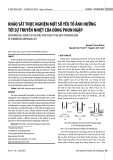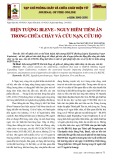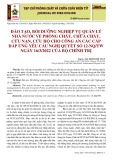
Ngô Thị Chinh / Tạp chí Khoa học và Công nghệ Đại học Duy Tân 02(69) (2025) 36-40
36
D U Y T A N U N I V E R S I T Y
Nghiên cứu cơ chế hấp phụ và tán xạ Raman tăng cường bề mặt của
formaldehyde trên vật liệu nano bạc và vàng bằng phương pháp DFT
A DFT study on the SERS mechanism of formaldehyde adsorbed on silver and gold
nanoparticle surfaces
Ngô Thị Chinha,b*
Ngo Thi Chinha,b*
aViện Nghiên cứu và Phát triển Công nghệ cao, Ðại học Duy Tân, Ðà Nẵng, Việt Nam
aInstitute of Research and Development, Duy Tan University, Da Nang, 550000, Viet Nam
bKhoa Môi trường và Khoa học tự nhiên, Trường Công nghệ và Kỹ thuật, Ðại học Duy Tân, Ðà Nẵng, Việt Nam
bFaculty of Environment and Natural Sciences, School of Engineering and Technology, Duy Tan University,
Da Nang, 550000, Viet Nam
(Ngày nhận bài: 27/11/2024, ngày phản biện xong: 06/12/2024, ngày chấp nhận đăng: 06/03/2025)
Tóm tắt
Tán xạ Raman tăng cường bề mặt (SERS) là một trong những phương pháp quang phổ nhạy có khả năng phát hiện
nhanh các chất ô nhiễm ở nồng độ thấp. Trong nghiên cứu này, chúng tôi nghiên cứu cơ chế hấp phụ và SERS của
formaldehyde trên vật liệu nano bạc, vàng và hợp kim của chúng. Chúng tôi sử dụng phương pháp phiếm hàm mật độ
(DFT) để mô phỏng cấu hình hấp phụ và tính toán phổ Raman, cũng như giải thích cơ chế. Các cluster 6 nguyên tử bạc
Ag6, vàng Au6 và hợp kim Ag6-nAun (n=1-5) được sử dụng làm chất nền hấp phụ để mô phỏng SERS. Kết quả cho thấy,
phức giữa formaldehyde và cluster kim loại được tạo thành từ sự tương tác của nguyên tử oxy và nguyên tử kim loại ở
đỉnh. Cơ chế tăng cường hóa học SERS được xác định bởi sự chuyển điện tử từ phân tử formaldehyde sang cluster. Hơn
nữa, hiệu ứng tăng cường mạnh nhất thu được ở phức Ag5Au1Fo và Ag4Au2Fo do sự chuyển điện tử tốt hơn hai dạng
nguyên chất. Như vậy, việc sử dụng hợp kim Ag-Au không chỉ tạo hiệu ứng SERS tốt, mà còn hạn chế sự oxy hóa so với
Ag nguyên chất và giúp giảm thiểu chi phí so với việc sử dụng Au nguyên chất.
Từ khóa: SERS; formaldehyde; DFT; vật liệu nano vàng; vật liệu nano bạc.
Abstract
Surface-enhanced Raman scattering (SERS) is a highly sensitive spectroscopic method for the rapid detection of
pollutants at low concentrations. In this study, we investigated the adsorption and SERS mechanism of formaldehyde on
silver, gold, and their alloy nanomaterials. We employed density functional theory (DFT) to simulate the adsorption
configurations, calculate the Raman spectra, and elucidate the underlying mechanism. For our SERS simulation, we used
Ag6, Au6, and alloy clusters of the form Ag6-nAun (n=1-5) as the adsorption substrates. The results revealed that the
complexes between formaldehyde and metallic clusters were formed through the interaction of the oxygen atom in the
ligand with metallic atoms at the apex of the cluster. The SERS chemical enhancement mechanism was primarily driven
by the electron transfer from the formaldehyde molecule to the cluster. Additionally, the strongest enhancement effects
were observed in the Ag5Au1Fo and Ag4Au2Fo complexes which exhibited better electron transfer capabilities than the
pure forms. Therefore, using Ag-Au alloy not only creates a good SERS effect but also limits oxidation compared to pure
silver, while providing cost advantages over pure gold.
Keywords: SERS; formaldehyde; DFT; gold nanomaterial; silver nanomaterial.
*Tác giả liên hệ: Ngô Thị Chinh
Email: ngothichinh@duytan.edu.vn
02(69) (2025) 36-40
DTU Journal of Science and Technology

Ngô Thị Chinh / Tạp chí Khoa học và Công nghệ Đại học Duy Tân 02(69) (2025) 36-40
37
1. Giới thiệu
Formaldehyde là một chất hóa học được sử
dụng rộng rãi trong nhiều ngành công nghiệp
như thực phẩm, dệt may và da. Tuy nhiên, hợp
chất này cũng là mối lo ngại đáng kể đối với sức
khỏe con người do khả năng gây kích ứng và ung
thư của chúng. Một số nghiên cứu cũng cho thấy
sự tồn tại của formaldehyde trong thực phẩm [1,
2]. Vì vậy, việc phát hiện formaldehyde có ý
nghĩa rất lớn, đặc biệt trong phân tích thực phẩm.
Tán xạ Raman tăng cường bề mặt (Surface-
enhanced Raman Scattering-SERS) là một trong
những phương pháp quang phổ rất nhạy cho
phép phân tích nhanh các chất ở nồng độ thấp.
Nhiều nghiên cứu đã phát triển các loại vật liệu
SERS khác nhau để phân tích dư lượng các chất
ô nhiễm, bao gồm formaldehyde. Gu và cộng sự
[3] đã chế tạo hạt nano bạc làm chất nền cho
SERS để phát hiện gián tiếp formaldehyde ở
nồng độ giới hạn rất nhỏ 10-11 M thông qua phản
ứng Hantzsch. Nhóm nghiên cứu của Zhang-
Ying [4] đã điều chế sợi vàng làm chất nền cho
SERS để phát hiện lượng nhỏ formaldehyde
trong không khí trong nhà, dựa trên phản ứng
của nó với 4-amino-3-hydrazino-5-mercapto-1,
2, 4-triazol (AHMT). Ngoài ra, Ge và cộng sự
[5] cũng đã chế tạo các hạt hợp kim lai hóa
PbBiO2Br/Au4Ag4 để làm chất nền SERS trong
phát hiện nhanh, nhạy và có chọn lọc
formaldehyde. Zhao và đồng nghiệp [6] đã sử
dụng nano vàng làm chất nền SERS để phát hiện
và định lượng formaldehyde trong thực phẩm.
Bên cạnh các nghiên cứu thực nghiệm, tính
toán mô phỏng DFT (density functional theory)
đã được sử dụng để nghiên cứu cơ chế hấp phụ
và hiện tượng SERS [7-9]. Trong các nghiên cứu
này, các tác giả đã sử dụng các cluster kim loại
(như Ag, Au, và Cu) có số lượng nguyên tử lên
tới 20 để mô phỏng vật liệu nano làm chất nền
SERS phát hiện thuốc trừ sâu.
Trong nghiên cứu này chúng tôi sử dụng
cluster 6 nguyên tử bạc Ag6, vàng Au6 và hợp
kim của chúng Ag6-nAun (n=1-5) làm chất nền
hấp phụ để tính toán SERS cho hợp chất
formaldehyde. Phương pháp DFT được sử dụng
để tối ưu hóa các cấu hình tương tác khác nhau
giữa chất nghiên cứu và cluster. Phổ Raman và
SERS tương ứng của chúng cũng được tính toán.
Ngoài ra, giản đồ bề mặt thế năng tĩnh điện
(electrostatic potential-ESP) và điện tích nguyên
tử Mulliken được phân tích để làm rõ cơ chế
SERS.
2. Phương pháp nghiên cứu
Phần mềm Gaussian 16, phiên bản C.01 [10]
được sử dụng để thực hiện các tính toán DFT.
Phương pháp LC-BLYP [11] kết hợp bộ hàm cơ
sở cc-pVDZ-PP [12] cho nguyên tử Ag và Au và
cc-pVDZ [13] cho các nguyên tử của hợp chất
hữu cơ được áp dụng để tối ưu hóa cấu trúc, tính
toán tần số dao động và tín hiệu Raman. Giản đồ
bề mặt thế năng tĩnh điện (electrostatic potential-
ESP) được phân tích cho các phức chất giữa chất
nghiên cứu và cluster kim loại. Điện tích nguyên
tử Mulliken cũng được tính toán để giải thích cơ
chế chuyển điện tử và tăng cường của các phức
khác nhau.
3. Kết quả và thảo luận
3.1. Cấu dạng của các hỗn hợp cluster
Hình 1 biểu diễn cấu trúc tối ưu của các cluster
chứa 6 nguyên tử sử dụng mô phỏng vật liệu nano
bạc, vàng và hợp kim. Các cấu trúc bền nhất có
giá trị năng lượng tương đối 0.0 kcal/mol, các cấu
trúc còn lại có năng lượng tương đối cao hơn cấu
trúc bền từ 5.1 tới 8.8 kcal/mol. Kết quả cho thấy
cấu trúc hợp kim Ag(6-n)Aun (n= 1-3) bền nhất thu
được khi thay thế nguyên tử vàng tại các đỉnh của
cluster Ag6. Các nguyên tử thay thế tiếp theo cho
cluster Ag(6-n)Aun (n= 4-5) sẽ ở các nguyên tử còn
lại ở cạnh.

Ngô Thị Chinh / Tạp chí Khoa học và Công nghệ Đại học Duy Tân 02(69) (2025) 36-40
38
Hình 1. Cấu trúc tối ưu của các cluster bạc Ag6, vàng Au6 và hợp kim Ag(6-n)Aun (n= 1-5)
(Tên của các cluster bền nhất của mỗi dạng được viết màu đỏ. Giá trị trong ngoặc đơn tương ứng với năng lượng tự do
tương đối (kcal/mol). Nguyên tử bạc biểu thị bằng màu xanh nhạt, vàng có màu vàng).
3.2. Cơ chế hấp phụ của formaldehyde trên bề
mặt vật liệu
Các cấu trúc cluster bền nhất được sử dụng để
nghiên cứu tạo phức với formaldehyde. Tương
tác giữa formaldehyde và cluster kim loại được
xác định ở nguyên tử oxy giàu điện tử. Hình 2
biểu diễn cấu trúc tối ưu và giản đồ bề mặt thế
năng ESP cho phức tương tác giữa formadehyde
(Fo) và các cluster khác nhau. Cấu trúc tối ưu
(Hình 2A) cho thấy khoảng cách giữa nguyên tử
oxy của formaldehyde và nguyên tử kim loại của
cluster thay đổi từ 2.27 tới 2.38 Å.
Hình 2. Cấu trúc tối ưu (A) và giản đồ bề mặt thế năng tĩnh điện ESP (B) của các phức giữa formaldehyde (Fo)
và các cluster kim loại khác nhau
(Độ dài tương tác có đơn vị Å).
Giản đồ ESP cho thấy vùng màu đỏ đặc trưng
cho vùng giàu điện tử tập trung ở cluster, trong
khi vùng màu xanh thể hiện điện tích dương tìm
thấy ở phân tử).) formaldehyde. Điều này cho
thấy sự hấp phụ được tạo thành từ sự chuyển
điện tử từ phân tử sang cluster. Sự chuyển điện
tích này đặc trưng cho cơ chế hóa học của hiệu
ứng SERS.

Ngô Thị Chinh / Tạp chí Khoa học và Công nghệ Đại học Duy Tân 02(69) (2025) 36-40
39
3.3. Phân tích phổ SERS và cơ chế tăng cường tán xạ Raman
Phổ Raman của formaldehyde và SERS của phức giữa formaldehyde và cluster kim loại (ở Hình
2) được thể hiện ở Hình 3 dưới đây.
Hình 3. Phổ Raman của hợp chất formaldehyde (a); phổ SERS của formaldehyde hấp phụ trên vật liệu nano Ag6 (b),
Ag5Au1 (c), Ag4Au2 (d), Ag3Au3 (e), Ag2Au4 (f), Ag1Au5 (g) và Au6 (h).
Phổ Raman của formaldehyde (Hình 3a) chỉ
ra pic đặc trưng ở tần số 1530 cm-1 cho dao động
của nhóm C‒H và 1917 cm-1 cho nhóm C=O.
Khi hấp phụ trên vật liệu nano, các pic cho các
dao động đặc trưng này được tăng cường và dịch
chuyển về tần số nhỏ hơn ở khoảng 1513 tới
1518 cm-1 (C‒H) và 1863 tới 1875 cm-1 (C=O).
Điều đáng chú ý là cường độ tín hiệu Raman cho
nhóm C=O tại vị trí tương tác với cluster kim
loại thay đổi mạnh mẽ từ 4.3 A4/AMU (Hình 3a)
tới 45.0 A4/AMU (hấp phụ trên Ag6, Hình 3b),
pic đặc trưng cho nhóm C‒H thay đổi không
đáng kể. Khi thay thế các nguyên tử vàng vào
cluster Ag6 tạo hợp kim thì thấy hiệu ứng tăng
cường mạnh nhất thu được ở phức Ag5Au1Fo và
Ag4Au2Fo, khi nguyên tử oxy của formaldehyde
tương tác với nguyên tử Au của hợp kim. Thật
vậy, tín hiệu Raman cho pic C=O của hai phức
này lần lượt là 67.0 và 66.1 A4/AMU (Hình 3c
và d). Các giá trị này cao hơn tín hiệu tương ứng
ghi nhận cho cả hai dạng nguyên chất Ag6 (45.0
A4/AMU) và Au6 (63.9 A4/AMU). Điều này có
thể được giải thích thông qua sự thay đổi của
điện tích nguyên tử Mulliken cho formaldehyde
ban đầu và khi hấp phụ lên các cluster khác nhau
được trình bày ở Bảng 1.
Bảng 1. Điện tích nguyên tử Mulliken (đơn vị a.u) của tất cả các nguyên tử của formaldehyde
ban đầu và khi hấp phụ lên các cluster khác nhau.
Atom
C
O
H1
H2
Fo
0.103
-0.151
0.024
0.024
Ag6Fo
0.154
-0.128
0.085
0.073
Ag5Au1Fo
0.149
-0.117
0.083
0.069
Ag4Au2Fo
0.151
-0.118
0.085
0.071
Ag3Au3Fo
0.153
-0.121
0.087
0.075
Ag2Au4Fo
0.152
-0.120
0.086
0.074
Ag1Au6Fo
0.162
-0.128
0.096
0.081
Au6Fo
0.162
-0.128
0.096
0.081

Ngô Thị Chinh / Tạp chí Khoa học và Công nghệ Đại học Duy Tân 02(69) (2025) 36-40
40
Khi xem xét sự thay đổi diện tích của nguyên
tử oxy tại vị trí tương tác của formaldehyde với
các cluster, kết quả ở Bảng 1 cho thấy điện tích
của oxy tăng mạnh nhất ở phức Ag5Au1Fo
(-0.117 a.u) và Ag4Au2Fo (-0.118 a.u) so với giá
trị ban đầu -0.151 a.u. Điều này thể hiện sự
chuyển điện tử từ phân tử formaldehyde sang hai
cluster Ag5Au1 và Ag4Au2 là nhiều nhất, dẫn đến
sự tăng cường tán xạ Raman mạnh nhất ở hai
phức này. Hiện tượng tương tự đã được công bố
gần đây cho cluster hợp kim Ag-Cu [7]. Như vậy,
việc thay thế một hoặc hai nguyên tử Au vào
cluster Ag6 làm tăng cường đáng kể tín hiệu
Raman. Ngoài ra, việc sử dụng hợp kim Ag-Au
không chỉ tạo hiệu ứng SERS tốt, mà còn hạn chế
sự oxy hóa so với Ag nguyên chất và giúp giảm
thiểu chi phí so với việc sử dụng Au nguyên chất.
4. Kết luận
Trong nghiên cứu này, chúng tôi đã làm sáng
tỏ cơ chế hấp phụ và giải thích được hiện tượng
tán xạ Raman tăng cường bề mặt (SERS) cho
formaldehyde hấp phụ lên các vật liệu nano bạc
và vàng khác nhau bằng phương pháp tính toán
DFT. Kết quả cho thấy sự hấp phụ thể hiện ở
tương tác giữa nguyên tử oxy giàu điện tử của
formaldehyde và nguyên tử kim loại ở đỉnh
cluster. Cơ chế tăng cường hóa học của SERS
được đặc trưng bởi sự chuyển điện tử từ phân tử
sang cluster. Ngoài ra, việc sử dụng hợp kim
Ag5Au1 và Ag4Au2 làm chất nền SERS cho hiện
tượng tăng cường mạnh nhất nhờ vào khả năng
nhận điện tử tốt nhất của chúng khi tương tác với
nguyên tử oxy của formaldehyde.
Tài liệu tham khảo
[1] Nowshad, F., Islam, M. N., Khan, M. S. (2018).
''Concentration and formation behavior of naturally
occurring formaldehyde in foods''. Agriculture & Food
Security (7), 17. DOI:10.1186/s40066018-0166-4
[2] Jeong, H. S., Chung, H., Song, S. H., Kim, C. I., Lee,
J. G., Kim, Y. S. (2015). ''Validation and
Determination of the Contents of Acetaldehyde and
Formaldehyde in Foods''. Toxicological research
(31), 273-278. DOI: 10.5487/tr.2015.31.3.273
[3] Qu, W.-G., Lu, L.-Q., Lin, L., Xu, A.-W. (2012). "A
silver nanoparticle based surface enhanced resonance
Raman scattering (SERRS) probe for the
ultrasensitive and selective detection of
formaldehyde". Nanoscale (4), 7358-7361.
DOI:10.1039/C2NR32079G
[4] Lv, Z.-Y., Mei, L.-P., Chen, W.-Y., Feng, J.-J., Chen,
J.-Y., Wang, A.-J. (2014). ''Shaped-controlled
electrosynthesis of gold nanodendrites for highly
selective and sensitive SERS detection of
formaldehyde''. Sensors and Actuators B: Chemical
(201), 92-99. DOI: 10.1016/j.snb.2014.04.092
[5] Ge, K., Yi, L., Wu, Q., Li, Y., Zhang, H., Gu, Y.
(2021). ''Detection of Formaldehyde by Surface-
Enhanced Raman Spectroscopy Based on
PbBiO2Br/Au4Ag4 Nanospheres''. ACS Applied Nano
Materials (4), 10218-10227. DOI:
10.1021/acsanm.1c01710
[6] Zhao, Y.-X., Zhu, W.-W., Wu, Y.-Y., Chen, Y.-Y.,
Du, F.-K., Yan, J., Tan, X.-C., Wang, Q. (2021).
''Sensitive surface-enhanced Raman scattering for the
quantitative detection of formaldehyde in foods using
gold nanorod substrate''. Microchemical Journal
(160), 105727. DOI: 10.1016/j.microc.2020.105727
[7] Hiếu, T. Đ., Anh, N. T. L., Chinh, N. T., Quang, Đ.
D. (2024). ''SERS-Based Sensor Using
Subnanometric Copper–Silver Mixed Clusters Ag(8–
n)Cun (n = 0–8) for Pyridine: A DFT Study''. The
Journal of Physical Chemistry A (128), 2948-2959.
DOI: 10.1021/acs.jpca.3c08206
[8] Chinh, N. T., Thắng, T. Q., An, N. T. T., Trí, N. N.,
Trung, N. T., Hiếu, T. Đ., Huy, B. T., Thọ, N. M.,
Quang, Đ. D. (2020). ''SERS Spectra of the Pesticide
Chlorpyrifos Adsorbed on Silver Nanosurface: The
Ag20 Cluster Model''. The Journal of Physical
Chemistry C (124), 21702-21716. DOI:
10.1021/acs.jpcc.0c06078
[9] Dao, Đ. Q., Chinh, N. T., Hương, L. T. T., Thắng, T.
Q., Anh, N. T. L., Huy, B. T., Tri, N. N., Trung, N.
T., Thọ, N. M. (2021). ''SERS Chemical
Enhancement of 2,4,5-Trichlorophenoxyacetic Acid
Adsorbed on Silver Substrate''. The Journal of
Physical Chemistry A (125), 8529-8541. DOI:
10.1021/acs.jpca.1c04957
[10] Frisch, M. J., Trucks, G. W., Schlegel, H. B.,
Scuseria, G. E., Robb, M. A., Cheeseman, J. R.,
Scalmani, G., Barone, V., Petersson, G. A.,
Nakatsuji, H., et al. (2016). Gaussian 16 Rev. C.01.
Wallingford, CT.
[11] Iikura, H., Tsuneda, T., Yanai, T., Hirao, K. (2001).
''A long-range correction scheme for generalized-
gradient-approximation exchange functionals''. The
Journal of Chemical Physics (115), 3540-3544. DOI:
10.1063/1.1383587
[12] Peterson, K. A., Puzzarini, C. (2005).
''Systematically convergent basis sets for transition
metals. II. Pseudopotential-based correlation
consistent basis sets for the group 11 (Cu, Ag, Au)
and 12 (Zn, Cd, Hg) elements''. Theoretical
Chemistry Accounts (114), 283-296. DOI:
10.1007/s00214-005-0681-9
[13] Dunning, T. H., Jr. (1989). ''Gaussian basis sets for
use in correlated molecular calculations. I. The atoms
boron through neon and hydrogen''. The Journal of
Chemical Physics (90), 1007-1023. DOI:
10.1063/1.456153.


![Câu hỏi ôn tập Môi trường và phát triển [năm]](https://cdn.tailieu.vn/images/document/thumbnail/2025/20250710/kimphuong1001/135x160/2361752136158.jpg)
![Câu hỏi ôn tập Con người và môi trường: Tổng hợp [mới nhất/chuẩn nhất]](https://cdn.tailieu.vn/images/document/thumbnail/2025/20250704/kimphuong1001/135x160/8741751592841.jpg)
![Câu hỏi ôn tập môn Môi trường [chuẩn nhất]](https://cdn.tailieu.vn/images/document/thumbnail/2025/20250702/kimphuong555/135x160/62401751441591.jpg)
![Tài liệu tập huấn quản lý và bảo tồn đất ngập nước [mới nhất]](https://cdn.tailieu.vn/images/document/thumbnail/2025/20250627/vijiraiya/135x160/30351751010876.jpg)





![Tài liệu Vi sinh vật môi trường [Mới nhất]](https://cdn.tailieu.vn/images/document/thumbnail/2025/20251123/ngkimxuyen/135x160/21891763953413.jpg)
![Sổ tay truyền thông Phân loại chất thải rắn sinh hoạt trên địa bàn tỉnh Quảng Nam [Chuẩn nhất]](https://cdn.tailieu.vn/images/document/thumbnail/2025/20251114/kimphuong1001/135x160/1701763094001.jpg)


![Quản lý chất thải nguy hại: Sổ tay Môi trường [Chuẩn nhất]](https://cdn.tailieu.vn/images/document/thumbnail/2025/20251029/kimphuong1001/135x160/9011761720170.jpg)










